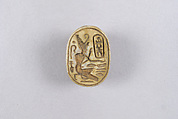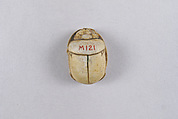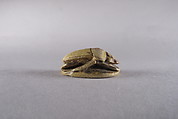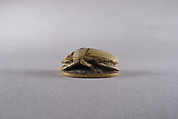Scarab with a Kneeling Pharaoh and the Name Menkheperre (Thutmose III)
New Kingdom
A man faces right and kneels down on his right knee. He is identified as the pharaoh by his crown, the Double Crown of Upper and Lower Egypt dressed with a uraeus on the front. However, the chin displays no royal beard. Within the kneeling figure details are carefully engraved, such as the folds of his kilt with ritual apron (sporran), a belt, a wesekh-collar around his neck, and the facial traits. Behind his back are the heqa-scepter and the nefer-hieroglyph, together forming the royal epithet ‘good ruler’, which was not frequently used on scarabs but is known to be associated with royal names of Dynasty 18 (ca. 1550-1295 B.C.). The king raises his right hand in front of him in a gesture of adoration while his left hand is stretched out to support an oval. The oval is suggestive of a cartouche and is inscribed with the name Menkheperre, known mainly as the throne name of Thutmose III (Dynasty 18, ca. 1479-1425 B.C.). The horizontal signs in front of the king are a debased rendering of the well-known royal title Lord of the Two Lands. A small dot in the upper left of the composition may refer to the sun disk of Re.
Due to rights restrictions, this image cannot be enlarged, viewed at full screen, or downloaded.
This artwork is meant to be viewed from right to left. Scroll left to view more.






